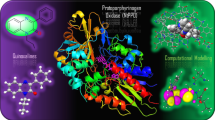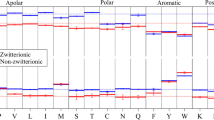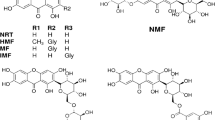Abstract
Study on the binding properties of helicid by pepsin systematically using multi-spectroscopic techniques and molecular docking method, and these interactions comprise biological recognition at molecular level and backbone of biological significance in medicine concerned with the uses, effects, and modes of action of drugs. We investigated the mechanism of interaction between helicid and pepsin by using various spectroscopic techniques viz., fluorescence spectra, UV–Vis absorption spectra, circular dichroism (CD), 3D spectra, synchronous fluorescence spectra and molecular docking methods. The quenching mechanism associated with the helicid–pepsin interaction was determined by performing fluorescence measurements at different temperatures. From the experimental results show that helicid quenched the fluorescence intensity of pepsin via a combination of static and dynamic quenching process. The binding constants (Ka) at three temperatures (288, 298, and 308 K) were 7.940 × 107, 2.082 × 105 and 3.199 × 105 L mol−1, respectively, and the number of binding sites (n) were 1.44, 1.14, and 1.18, respectively. The n value is close to unity, which means that there is only one independent class of binding site on pepsin for helicid. Thermodynamic parameters at 298 K were calculated as follows: ΔHo (− 83.85 kJ mol−1), ΔGo (− 33.279 kJ mol−1), and ΔSo (− 169.72 J K−1 mol−1). Based on thermodynamic analysis, the interaction of helicid with pepsin is driven by enthalpy, and Van der Waals’ forces and hydrogen bonds are the main forces between helicid and pepsin. A molecular docking study further confirmed the binding mode obtained by the experimental studies. The conformational changes in the structure of pepsin was confirmed by 3D fluorescence spectra and circular dichroism.









Similar content being viewed by others
References
Zhou X, Zhao TR, Nan GH, Li JY (1987) Influences of helicid on metabolism of four amino acids in the brain and synaptosomes in mice. Acta Pharmacol Sin 8:393–396
Fan R, Gan L, Liu M, Zhu D, Chen L, Xu Z, Hao Z, Chen L (2011) An interaction of helicid with liposome biomembrane. Appl Surf Sci 257:2102–2106
Yi W, Cao RH, Wen H, Yan Q, Zhou BH, Wan YQ, Ma L, Song HC (2008) Synthesis and biological evaluation of helicid analogues as mushroom tyrosinase inhibitors. Bioorg Med Chem Lett 18:6490–6493
Liu GY, Ma SC, Zhang YM, Xu JM, Lin RC (2005) Study on chemical constituents in seeds of Helicia nilagirica (II). China J Chin Mat Med 30:830–832
Ha JH, Lee DU, Lee JT, Kim JS, Yong CS, Kim JA, Ha JS, Huh K (2000) 4-Hydroxybenzaldehyde from Gastrodia elata B1. is active in the antioxidation and GABAergic neuromodulation of the rat brain. J Ethnopharmacol 73:329–333
Liu P, Li J, Na DQ, Geng JM, Li S (2002) Neurobehavioral effects of helicid on Wistar rat’s offspring. Zhongcaoyao 33:238–242
Liu G, Wang G, Ma S, Lin R (2004) General situation of research on active ingredients of medicinal plants in Longan. Chin Tradit Herb Drugs 35:593–595
Lan S, Li J, Xiong S, Wan C, Lv M (2007) Helicia tablets and sleep health conducting to treat patients with insomnia. Chin J New Drugs Clin Rem 26:604–606
Lan SZ, Li J, Xiong SC, Wan C, Lv MZ (2007) Helicia tablets and sleep health conducting to treat patients with insomnia. Chin J New Drugs Clin Rem 26:604–606
Wen H, Lin C, Que L, Ge H, Ma L, Cao R, Wan Y, Peng W, Wang Z, Song H (2008) Synthesis and biological evaluation of helicid analogues as novel acetylcholinesterase inhibitors. Eur J Med Chem 43:166–173
Yue Y, Liu J, Liu R, Dong Q, Fan J (2014) Binding of helicid to human serum albumin: A hybrid spectroscopic approach and conformational study. Spectrochim Acta Part A 124:46–51
Maeda K, Fukuda M, Griffith CE, Finkel LJ, Hamilton TA, Bulengo-Ransby SM (1996) Mechanism of its depigmenting action in human melanocyte culture. J Pharmacol Exp Ther 276:765–769
Wang R, Xie Y, Zhang Y, Kang X, Wang X, Ge B, Chang J (2013) Comparative study of the binding of pepsin to four alkaloids by spectrofluorimetry. Spectrochim Acta A 108:62–74
Zhang H, Cao J, Fei Z, Wang Y (2012) Investigation on the interaction behavior between bisphenol A and pepsin by spectral and docking studies. J Mol Struct 1021:34–39
Gole A, Dash C, Rao M, Sastry M (2000) Encapsulation and biocatalytic activity of the enzyme pepsin in fatty lipid films by selective electrostatic interactions. Chem Commun 4:297–298
Zeng HJ, Yang R, Liang H, Qu LB (2015) Molecular interactions of flavonoids to pepsin: insights from spectroscopic and molecular docking studies. Spectrochim Acta A 151:576–590
Yue Y, Zhao S, Liu J, Yan X, Sun Y (2017) Probing the binding properties of dicyandiamide with pepsin by spectroscopy and docking methods. Chemosphere 185:1056–1062
Jin KS, Rho Y, Kim J, Kim H, Kim IJ, Ree M (2008) Synchrotron small-angle Xray scattering studies of the structure of porcine pepsin under various pH conditions. J Phys Chem B 112:15821–15827
Van deWeert M, Stella L (2011) Fluorescence quenching and ligand binding: a critical discussion of a popular methodology. J Mol Struct 998(1):144–150
Omidvar Z, Asoodeh A, Chamani J (2013) Studies on the antagonistic behavior between cyclophosphamide hydrochloride and aspirin with human serum albumin: time-resolved fluorescence spectroscopy and isothermal titration calorimetry. J Solut Chem 42:1005–1017
Wu Z, Shen L, Han Q, Lu J, Tang H, Xu X, Xu H, Huang F, Xie J, He Z, Zeng Z, Hu Z (2017) Mechanism and nature of inhibition of trypsin by Ligupurpuroside A, a ku-ding tea extract, studied by spectroscopic and docking methods. Food Biophys 12:78–87
Shen L, Xu H, Huang F, Li Y, Xiao H, Yang Z, Hu Z, He Z, Zeng Z, Li Y (2014) Investigation on interaction between Ligupurpuroside A and pepsin by spectroscopic and docking methods. Spectrochim Acta Part A 135:256–263
Ying M, Huang FW, Ye HD, Xu H, Shen LL, Huan TW, Huang ST, Xie JF, Tian SL, Hua ZL, He ZD, Lu J, Zhou K (2015) Study on interaction between curcumin and pepsin by spectroscopic and docking methods. Int J Biol Macromol 79:201–208
Lakowicz JR, Weber G (1973) Quenching of fluorescence by oxygen. A probe for structural fluctuations in macromolecules. Biochemistry 12:1461–4170
Wang Q, Huang CR, Jiang M, Zhu YY, Wang J, Chen J, Shi JH (2016) Binding interaction of atorvastatin with bovine serum albumin: spectroscopic methods and molecular docking. Spectrochim Acta A 156:155–163
Zhou Q, Xiang J, Tang Y, Liao J, Yu C, Zhang H, Li L, Yang Y, Xu G (2008) Investigation on the interaction between a heterocyclic aminal derivative, SBDC, and human serum albumin. Colloids Surf B 61:75–80
Gerbanowski A, Malabat C, Rabiller C, Gueguen J (1999) Grafting of aliphatic and aromatic probes on rapeseed 2S and 12S proteins: influence on their structural and physicochemical properties. J Agric Food Chem 47:5218–5226
Ward LD (1985) Measurement of ligand binding to proteins by fluorescence spectroscopy. Methods Enzymol 117:400–414
Lakowicz JR (2006) Principles of fluorescence spectroscopy, third edn. Springer, New York
Roy AS, Tripathy DR, Ghosh AK, Dasgupta S (2012) An alternate mode of binding of the polyphenol quercetin with serum albumins when complexed with Cu(II). J Lumin 132:2943–2951
Hossein MA, Dolatabadi JEN, Dehghan P, Vahid PA, Barzegar A (2017) Multi-spectroscopic and molecular modeling studies of bovine serum albumin interaction with sodium acetate food additive. Food Chem 228:265–269
Xiang G, Tong C, Lin H (2007) Nitroaniline isomers interaction with bovine serum albumin and toxicological implications. J Fluoresc 17:512–521
Zhang YZ, Dai J, Zhang XP, Yang X, Liu Y (2008) Studies of the interaction between sudan I and bovine serum albumin by spectroscopic methods. J Mol Struct 888:152–159
Rashidipour S, Naeeminejad S, Chamani J (2016) Study of the interaction between DNP and DIDS with human hemoglobin as binary and ternary systems: spectroscopic and molecular modeling investigation. J Biomol Struct Dyn 34:57–77
Moosavi-Movahedi AA, Chamani J, Gharanfoli M, Hakimelahi GH (2004) Differential scanning calorimetric study of the molten globule state of cytochrome c induced by sodium n-dodecyl sulfate. Thermochim Acta 409:137–144
Deepti S, Himanshu O, Mallika P, Bhawna S, Navneet S, Anju S, Rita K, Rakesh KS (2016) Spectroscopic and molecular modelling studies of binding mechanism of metformin with bovine serum albumin. J Mol Struct 1118:267–274
Zhu SZ, Liu Y (2012) Spectroscopic analyses on interaction of Naphazoline hydrochloride with bovine serum albumin. Spectrochim Acta A 98:142–147
Nascimento GNLD, Montalvao EV, Aversi-Ferreira TA (2012) Study of the pepsin enzymatic activity in in-vitro dissolution test of bromazepam tablets by UV/VIS spectrophotometry. J Appl Pharm Sci 2(10):11–15
Marouzia S, Rada AS, Beigolib S, Baghaeea PT, Darbana RA, Chamania J (2017) Study on effect of lomefloxacin on human holo-transferrin in the presence of essential and nonessential amino acids: spectroscopic and molecular modeling approaches. Int J Biol Macro 97:688–699
Sułkowska A (2002) Interaction of drugs with bovine and human serum albumin. J Mol Struct 614:227–232
Liu R, Cheng Z, Jiang X (2014) Comparative studies on the interactions of dihydroartemisinin and artemisinin with bovine serum albumin using spectroscopic methods. Luminescence 29:1033–1046
Zhang LN, Wu FY, Liu AH (2011) Study of the interaction between 2, 5-di-[2-(4-hydroxy-phenyl)ethylene]-terephthalonitril and bovine serum albumin by fluorescence spectroscopy. Spectrochim Acta A 79:97–103
Lloyd JBF (1971) Nature and evidential value of luminescence of automobile engine oils and related materials. 1. Synchronous excitation of fluorescence emission. J Forensic Sci Soc 11:83–94
Abert WC, Gregory WM, Allan GS (1993) The binding interaction of coomassie blue with proteins. Anal Biochem 213:407–413
Fan JC, Chen X, Wang Y, Fan CP, Shang ZC (2006) Binding interactions of pefloxacin mesylate with bovine lactoferrin and human serum albumin. J Zhejiang Univ Sci B 7:452–458
Hu YJ, Liu Y, Wang JB, Xiao XH, Qu SS (2004) Study of the interaction between monoammonium glycyrrhizinate and bovine serum albumin. J Pharm Biomed Anal 36:915–919
Meti MD, Nandibewoor ST, Joshi SD, More UA, Chimatadar SA (2016) Binding interaction and conformational changes of human serum albumin with ranitidine studied by spectroscopic and timeresolved fluorescence methods. J Iran Chem Soc 13:1325–1338
Chamani J (2006) Comparison of the conformational stability of the non-native α-helical intermediate of thiol-modified β-lactoglobulin upon interaction with sodium n-alkyl sulfates at two different pH. J Colloid Interfaces Sci 299:636–646
Azimi O, Emami Z, Salari H, Chamani J (2011) Probing the interaction of human serum albumin with norfloxacin in the presence of high-frequency electromagnetic fields: fluorescence spectroscopy and circular dichroism investigations. Molecules 16:9792–9818
Shen GF, Liu TT, Wang Q, Jiang M, Shi JH (2015) Spectroscopic and molecular docking studies of binding interaction of gefitinib, lapatinib and sunitinib with bovine serum albumin (BSA). J Photochem Photobiol B 153:380–390
Acknowledgements
This work was supported by the National Natural Science Foundation of China [Grant Numbers 31540012, 31470431, and 31670360], Guangdong Natural Science Foundation for Major cultivation project [Grant Number 2014A030308017], Shenzhen Science and Technology Innovation Committee Grants [Grant Numbers JSGG20160229120821300, JCYJ20150625103526744, CXZZ20150529165110750, JSGG20130411160539208, JCYJ20170302144535707, KQCX20140522111508785, CXZZ20150601110000604, and ZDSYS201506031617582], and Shenzhen special funds for Bio-industry development [Grant Number NYSW20140327010012].
Author information
Authors and Affiliations
Corresponding author
Ethics declarations
Conflict of interest
The authors declare that they have no conflict of interest.
Research involving human and animal rights
This article does not contain any studies with human participants or animals performed by any of the authors.
Rights and permissions
About this article
Cite this article
Meti, M.D., Xu, Y., Xie, J. et al. Multi-spectroscopic studies on the interaction between traditional Chinese herb, helicid with pepsin. Mol Biol Rep 45, 1637–1646 (2018). https://doi.org/10.1007/s11033-018-4306-5
Received:
Accepted:
Published:
Issue Date:
DOI: https://doi.org/10.1007/s11033-018-4306-5




